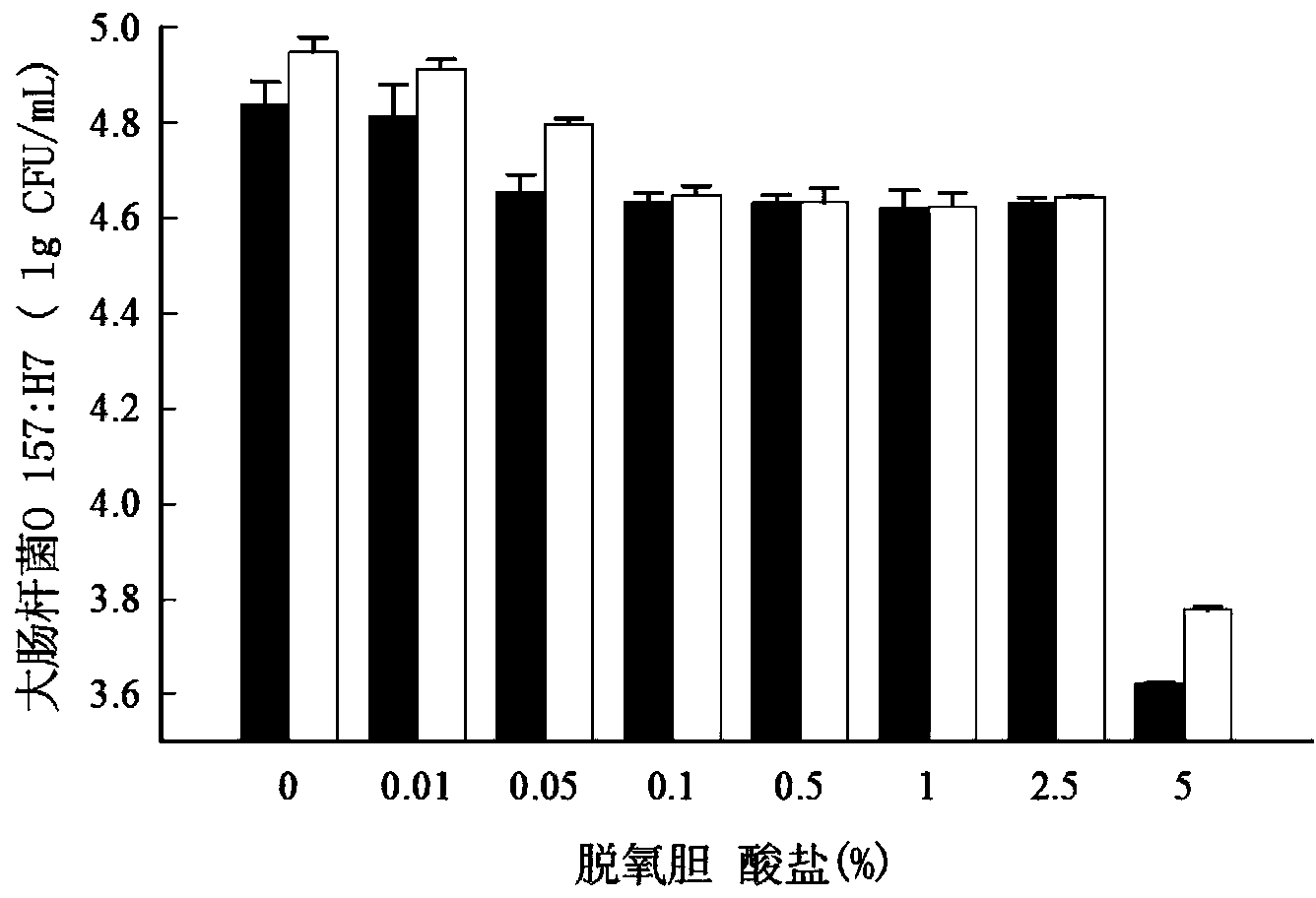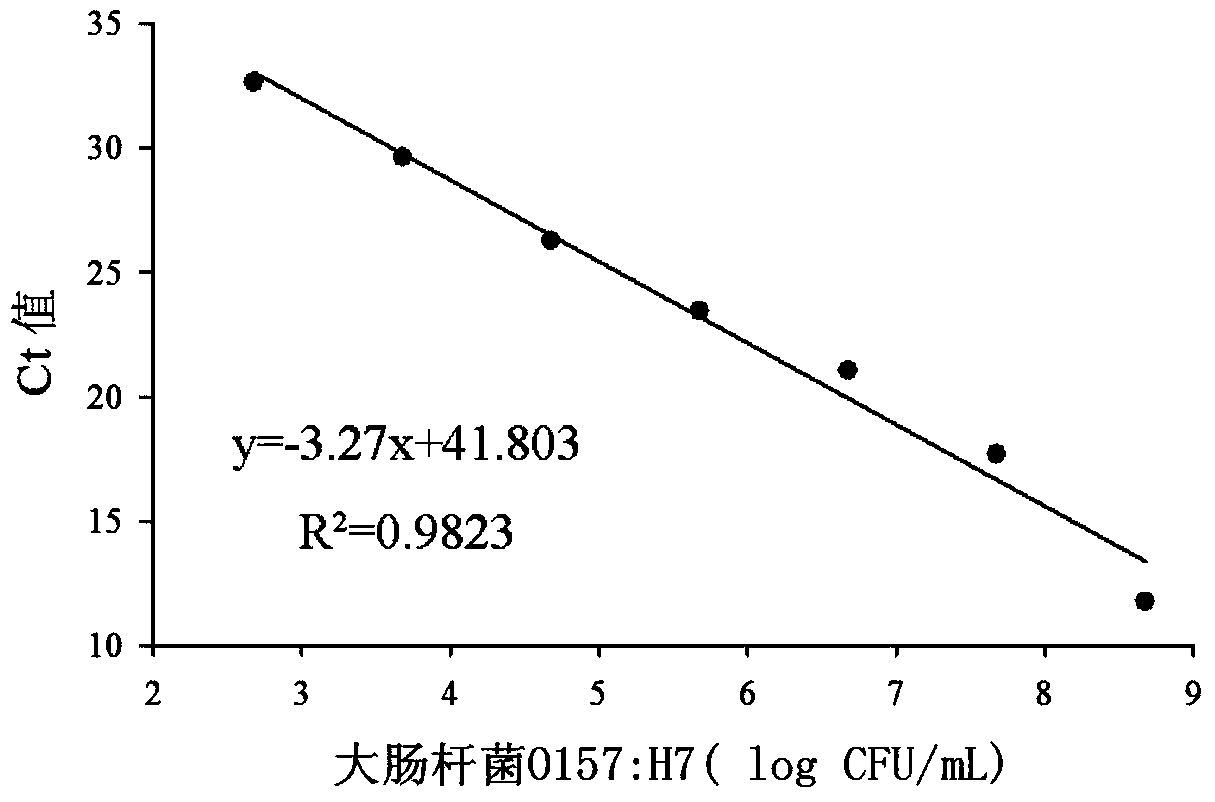Quantitative detection method for escherichia coli O157:H7 live bacteria in food
A quantitative detection method, Escherichia coli technology, which is applied in the field of microbial detection, can solve the problems of inability to effectively inhibit PCR amplification, and achieve the effect of improving detection sensitivity and high sensitivity
- Summary
- Abstract
- Description
- Claims
- Application Information
AI Technical Summary
Problems solved by technology
Method used
Image
Examples
Embodiment 1
[0025] The optimization of embodiment 1 deoxycholate concentration and processing time
[0026] Weigh a certain amount of deoxycholate (SD) and dissolve it in 0.1% (m(g) / v(mL)) peptone water to make SD with a concentration of 5% (m(g) / v(mL)). The mother solution was stored at 4°C in the dark.
[0027] Propidium azide bromide (PMA) was dissolved in dimethyl sulfoxide (DMSO), prepared into a 0.5 mg / mL PMA solution, and stored at -20°C in the dark.
[0028] Pick a single colony of Escherichia coli O157:H7 (British Type Culture Collection) in 5mL of LB medium, culture overnight at 37°C, take 1mL of the bacterial solution and dilute two gradients serially tenfold with PBS to obtain about 10 6 CFU / mL. Centrifuge at 12000rpm for 10min, and resuspend with an equal volume of 0.1% (m(g) / v(mL)) peptone water. The resuspended bacteria solution was placed at -70°C for 10 minutes and then bathed in water at 9°C for 30 minutes to obtain a mixture of injured bacteria, live bacteria and dea...
Embodiment 2
[0030] Pick a single colony of Escherichia coli O157:H7 (British Type Culture Collection) in 5 mL of LB medium, and culture overnight at 37°C. Take 1 mL of bacterial liquid in a 1.5 mL centrifuge tube, serially dilute ten times with PBS, and count the bacterial liquid concentration as 4.78×10 8 , 4.78×10 7 , 4.78×10 6 , 4.78×10 5 , 4.78×10 4 , 4.78×10 3 and 4.78×10 2CFU / mL. Take 500 μL of different concentrations of bacterial liquid and use the boiling water bath method to extract genomic DNA. The logarithm of the number of live bacteria obtained by plate counting is the abscissa, and the Ct value of the fluorescent quantitative PCR is used as the ordinate to draw the E. coli O157:H7 standard curve: y=-3.27x+41.803, see image 3 .
Embodiment 3
[0031] Example 3. Quantitative detection of live bacteria of Escherichia coli O157:H7 in food
[0032] 1) Food sample pretreatment
[0033] Weigh 1g or 1mL of food samples without objective bacteria, add 9mL of PBS phosphate buffer solution, grind to make a homogenate, add different concentrations of Escherichia coli O157:H7 to ensure a concentration of 10 7 -10 2 CFU / mL, centrifuge at 800rpm for 5 minutes, remove large food residues, and take the supernatant (this process must be performed aseptically)
[0034] 2) Magnetic bead enrichment
[0035] Take 980 μL of the bacterial suspension in step 1) and add it to a sterilized centrifuge tube, add 0.05 mg of immunomagnetic beads coupled with E.coli O157:H7 antibody, the particle size of the magnetic beads is 180 nm, and place it on a rotary mixer at room temperature at 10 rpm After rotating for 45 minutes, insert the centrifuge tube into a magnetic stand for separation for 3 minutes, suck out the supernatant with a pipette, a...
PUM
| Property | Measurement | Unit |
|---|---|---|
| Particle size | aaaaa | aaaaa |
Abstract
Description
Claims
Application Information
 Login to View More
Login to View More - R&D
- Intellectual Property
- Life Sciences
- Materials
- Tech Scout
- Unparalleled Data Quality
- Higher Quality Content
- 60% Fewer Hallucinations
Browse by: Latest US Patents, China's latest patents, Technical Efficacy Thesaurus, Application Domain, Technology Topic, Popular Technical Reports.
© 2025 PatSnap. All rights reserved.Legal|Privacy policy|Modern Slavery Act Transparency Statement|Sitemap|About US| Contact US: help@patsnap.com



